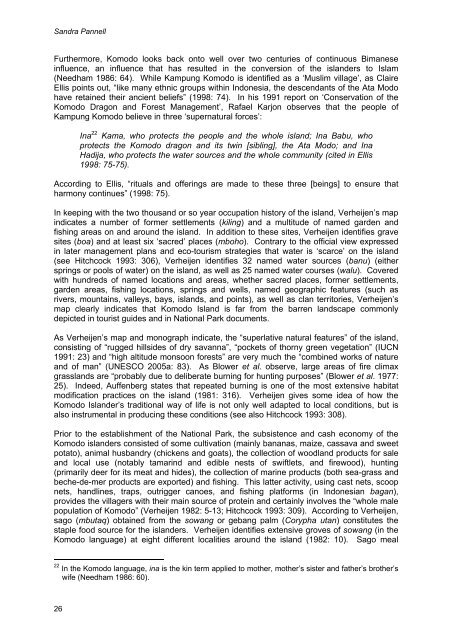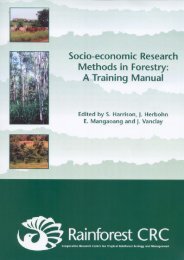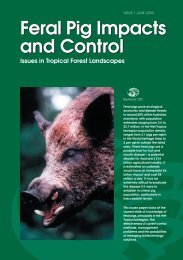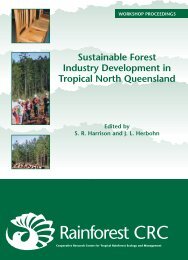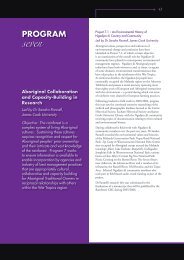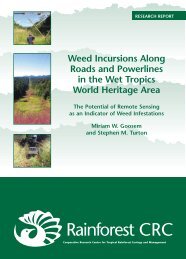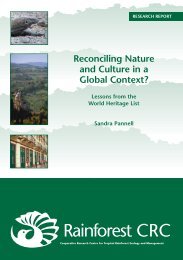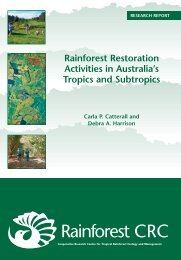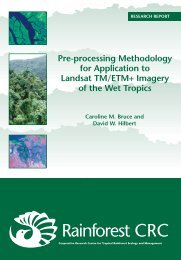Reconciling Nature and Culture in a Global Context? - Rainforest ...
Reconciling Nature and Culture in a Global Context? - Rainforest ...
Reconciling Nature and Culture in a Global Context? - Rainforest ...
Create successful ePaper yourself
Turn your PDF publications into a flip-book with our unique Google optimized e-Paper software.
S<strong>and</strong>ra PannellFurthermore, Komodo looks back onto well over two centuries of cont<strong>in</strong>uous Bimanese<strong>in</strong>fluence, an <strong>in</strong>fluence that has resulted <strong>in</strong> the conversion of the isl<strong>and</strong>ers to Islam(Needham 1986: 64). While Kampung Komodo is identified as a ‘Muslim village’, as ClaireEllis po<strong>in</strong>ts out, “like many ethnic groups with<strong>in</strong> Indonesia, the descendants of the Ata Modohave reta<strong>in</strong>ed their ancient beliefs” (1998: 74). In his 1991 report on ‘Conservation of theKomodo Dragon <strong>and</strong> Forest Management’, Rafael Karjon observes that the people ofKampung Komodo believe <strong>in</strong> three ‘supernatural forces’:Ina 22 Kama, who protects the people <strong>and</strong> the whole isl<strong>and</strong>; Ina Babu, whoprotects the Komodo dragon <strong>and</strong> its tw<strong>in</strong> [sibl<strong>in</strong>g], the Ata Modo; <strong>and</strong> InaHadija, who protects the water sources <strong>and</strong> the whole community (cited <strong>in</strong> Ellis1998: 75-75).Accord<strong>in</strong>g to Ellis, “rituals <strong>and</strong> offer<strong>in</strong>gs are made to these three [be<strong>in</strong>gs] to ensure thatharmony cont<strong>in</strong>ues” (1998: 75).In keep<strong>in</strong>g with the two thous<strong>and</strong> or so year occupation history of the isl<strong>and</strong>, Verheijen’s map<strong>in</strong>dicates a number of former settlements (kil<strong>in</strong>g) <strong>and</strong> a multitude of named garden <strong>and</strong>fish<strong>in</strong>g areas on <strong>and</strong> around the isl<strong>and</strong>. In addition to these sites, Verheijen identifies gravesites (boa) <strong>and</strong> at least six ‘sacred’ places (mboho). Contrary to the official view expressed<strong>in</strong> later management plans <strong>and</strong> eco-tourism strategies that water is ‘scarce’ on the isl<strong>and</strong>(see Hitchcock 1993: 306), Verheijen identifies 32 named water sources (banu) (eitherspr<strong>in</strong>gs or pools of water) on the isl<strong>and</strong>, as well as 25 named water courses (walu). Coveredwith hundreds of named locations <strong>and</strong> areas, whether sacred places, former settlements,garden areas, fish<strong>in</strong>g locations, spr<strong>in</strong>gs <strong>and</strong> wells, named geographic features (such asrivers, mounta<strong>in</strong>s, valleys, bays, isl<strong>and</strong>s, <strong>and</strong> po<strong>in</strong>ts), as well as clan territories, Verheijen’smap clearly <strong>in</strong>dicates that Komodo Isl<strong>and</strong> is far from the barren l<strong>and</strong>scape commonlydepicted <strong>in</strong> tourist guides <strong>and</strong> <strong>in</strong> National Park documents.As Verheijen’s map <strong>and</strong> monograph <strong>in</strong>dicate, the “superlative natural features” of the isl<strong>and</strong>,consist<strong>in</strong>g of “rugged hillsides of dry savanna”, “pockets of thorny green vegetation” (IUCN1991: 23) <strong>and</strong> “high altitude monsoon forests” are very much the “comb<strong>in</strong>ed works of nature<strong>and</strong> of man” (UNESCO 2005a: 83). As Blower et al. observe, large areas of fire climaxgrassl<strong>and</strong>s are “probably due to deliberate burn<strong>in</strong>g for hunt<strong>in</strong>g purposes” (Blower et al. 1977:25). Indeed, Auffenberg states that repeated burn<strong>in</strong>g is one of the most extensive habitatmodification practices on the isl<strong>and</strong> (1981: 316). Verheijen gives some idea of how theKomodo Isl<strong>and</strong>er’s traditional way of life is not only well adapted to local conditions, but isalso <strong>in</strong>strumental <strong>in</strong> produc<strong>in</strong>g these conditions (see also Hitchcock 1993: 308).Prior to the establishment of the National Park, the subsistence <strong>and</strong> cash economy of theKomodo isl<strong>and</strong>ers consisted of some cultivation (ma<strong>in</strong>ly bananas, maize, cassava <strong>and</strong> sweetpotato), animal husb<strong>and</strong>ry (chickens <strong>and</strong> goats), the collection of woodl<strong>and</strong> products for sale<strong>and</strong> local use (notably tamar<strong>in</strong>d <strong>and</strong> edible nests of swiftlets, <strong>and</strong> firewood), hunt<strong>in</strong>g(primarily deer for its meat <strong>and</strong> hides), the collection of mar<strong>in</strong>e products (both sea-grass <strong>and</strong>beche-de-mer products are exported) <strong>and</strong> fish<strong>in</strong>g. This latter activity, us<strong>in</strong>g cast nets, scoopnets, h<strong>and</strong>l<strong>in</strong>es, traps, outrigger canoes, <strong>and</strong> fish<strong>in</strong>g platforms (<strong>in</strong> Indonesian bagan),provides the villagers with their ma<strong>in</strong> source of prote<strong>in</strong> <strong>and</strong> certa<strong>in</strong>ly <strong>in</strong>volves the “whole malepopulation of Komodo” (Verheijen 1982: 5-13; Hitchcock 1993: 309). Accord<strong>in</strong>g to Verheijen,sago (mbutaq) obta<strong>in</strong>ed from the sowang or gebang palm (Corypha utan) constitutes thestaple food source for the isl<strong>and</strong>ers. Verheijen identifies extensive groves of sowang (<strong>in</strong> theKomodo language) at eight different localities around the isl<strong>and</strong> (1982: 10). Sago meal22 In the Komodo language, <strong>in</strong>a is the k<strong>in</strong> term applied to mother, mother’s sister <strong>and</strong> father’s brother’swife (Needham 1986: 60).26


